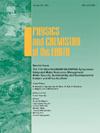利用加权反距离函数评估土地利用/土地覆盖对赞比亚 Bangweulu 小流域地表水质量的影响
IF 3
3区 地球科学
Q2 GEOSCIENCES, MULTIDISCIPLINARY
引用次数: 0
摘要
水质对人类健康和水生生态系统至关重要,随着城市和工业的发展,了解土地利用/土地覆盖(LULC)与水质之间的关系至关重要。本研究旨在调查 LULC 对特定水质参数的影响,建立 34 个采样点的水质指数(WQI),并评估 LULC 对水质指数的影响。研究使用了参数加权距离函数,其中加权反距离函数(WIDF)用于利用 Landsat 2020 分类图像和 30 米 DEM 确定特定地点每种 LULC 类型的污染有效贡献面积(Aec)。结果显示,水质指数值的范围很广,土地利用、土地利用变化和水质之间存在几种显著的相关性。浊度、溶解性总固体(TDS)、铁(Fe2+)和导电率(EC)与土地利用、土地利用变化(LULC)有很强的相关性(R2 > 0.7)。浊度和 Fe2+ 与建筑密集区和森林覆盖区的相关性更高(p-Value <0.05)。而 TDS 和 EC 与耕地的相关性更高(p-Value <0.05)。粪大肠菌群与土地利用、土地利用变化(LULC)的相关性较弱(R2 = 0.258),但与建筑密集区有显著相关性(p-Value <0.05)。水质指数与土地利用、土地利用变化(LULC)具有合理的相关性(R2 = 0.649)。了解这些关系可以改善土地利用规划和水质管理决策,预测河流水质,并制定可持续的 LULC 政策。这些信息还有助于确定潜在的水质退化热点,并为有针对性的干预和恢复工作指明方向。本文章由计算机程序翻译,如有差异,请以英文原文为准。
Assessing land-use/land-cover influence on surface water quality using a weighted inverse distance function in Bangweulu sub-catchment area, Zambia
Water quality is crucial for human health and aquatic ecosystems, and understanding the relationship between land use/land cover (LULC) and water quality is essential as urban and industrial growth expands. This study aimed to investigate the influence of LULC on specific water quality parameters, establish the Water Quality Index (WQI) for 34 sampling points, and assess the impact of LULC on the WQI. The study used parametric weighted distance function where the weighted inverse distance function (WIDF) was used in determining the contamination effective contribution area (Aec) for each LULC type of a particular location using Landsat 2020 classified image and 30 m DEM. The results showed a wide range of WQI values, with several significant correlations between LULC and water quality. Turbidity, total dissolved solids (TDS), iron (Fe2+), and electrical conductivity (EC) showed strong correlations with LULC (R2 > 0.7). Turbidity and Fe2+ were more correlated with built-up and forested areas (p-Value <0.05), respectively. Whereas, TDS and EC were more correlated with cropland (p-Value <0.05). The feacal coliform showed a weak correlation with LULC (R2 = 0.258), but had a significant correlation with built-up areas (p-Value <0.05). The WQI had a reasonable correlation with LULC (R2 = 0.649). Understanding these relationships could improve decision-making on land use planning and water quality management, predict river water quality, and shape sustainable LULC policies. This information could also help identify hotspots of potential water quality degradation and pinpoint areas for targeted interventions and restoration efforts.
求助全文
通过发布文献求助,成功后即可免费获取论文全文。
去求助
来源期刊

Physics and Chemistry of the Earth
地学-地球科学综合
CiteScore
5.40
自引率
2.70%
发文量
176
审稿时长
31.6 weeks
期刊介绍:
Physics and Chemistry of the Earth is an international interdisciplinary journal for the rapid publication of collections of refereed communications in separate thematic issues, either stemming from scientific meetings, or, especially compiled for the occasion. There is no restriction on the length of articles published in the journal. Physics and Chemistry of the Earth incorporates the separate Parts A, B and C which existed until the end of 2001.
Please note: the Editors are unable to consider submissions that are not invited or linked to a thematic issue. Please do not submit unsolicited papers.
The journal covers the following subject areas:
-Solid Earth and Geodesy:
(geology, geochemistry, tectonophysics, seismology, volcanology, palaeomagnetism and rock magnetism, electromagnetism and potential fields, marine and environmental geosciences as well as geodesy).
-Hydrology, Oceans and Atmosphere:
(hydrology and water resources research, engineering and management, oceanography and oceanic chemistry, shelf, sea, lake and river sciences, meteorology and atmospheric sciences incl. chemistry as well as climatology and glaciology).
-Solar-Terrestrial and Planetary Science:
(solar, heliospheric and solar-planetary sciences, geology, geophysics and atmospheric sciences of planets, satellites and small bodies as well as cosmochemistry and exobiology).
 求助内容:
求助内容: 应助结果提醒方式:
应助结果提醒方式:


